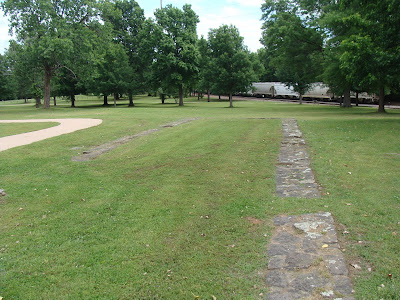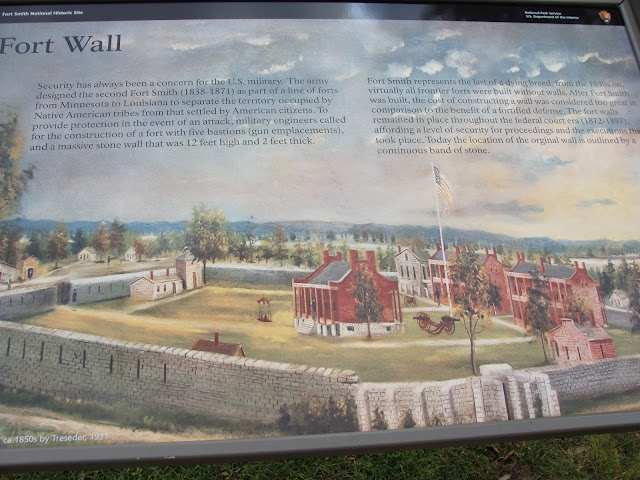From our campsite in Ozark, we make the 39 mile drive to Fort Smith in about 45 minutes. Finding a parking space was easy and we had a short walk to the visitor center which is located in the building that was once the courthouse, barracks, and jail. We were greeted by a friendly and knowledgeable person at the information desk. After listening to him give us an overview of this National Historic Site, we watched a short, but informative, video about the history of Fort Smith.
The original Fort Smith was built in 1817 to keep the peace between the Osage and Cherokee Indians. It was located on the Arkansas and Poteau rivers at Belle Point. The original fort was made of stone and logs. But, by 1824, the frontier had already moved farther west, so the army abandon the fort and move farther west to help keep the peace.
This is a drawing of what the first fort looked like
The logs have long since rotted away and the stone foundation is all that remains today.
The second Fort Smith was built in 1838 out of fear of an Indian attack. But by the mid 1840's the forts built farther west required a supply depot, and Fort Smith became an important supply depot. The Arkansas River was the main means of bringing supplies here from St. Louis and it also was the main water route for the "trail of tears" movement of Indians from the East to reservations in Oklahoma.
This is a painting of the second fort Smith showing the wall around the fort. The building in the center and lower right corner are still standing today as you will see next.
This is the commissary used to house the supplies that arrived here to support forts farther West. It is the building pictured in the lower right corner in the above painting.
The old courthouse was in the right half of this building and the jail was in the left half basement. This building is in the center of the painting shown above.
The jail could hold up to fifty men and had no heat, ventilation, or indoor toilets. It was called "Hell on the Border", due to the unbearable conditions. The court house on the right was used by the famous Judge Isaac C. Parker, better know as "the hanging judge". This building is now the visitors center and a museum.
The hanging gallows were first used in 1873. It was capable of hanging 12 people at one time. But the most people ever hanged at one time here was 6. Judge Parker sentenced 160 men to hang. But only 86 were actually hanged in 39 separate executions. After seeing these gallows, we decided not to hang around here any longer!







No comments:
Post a Comment